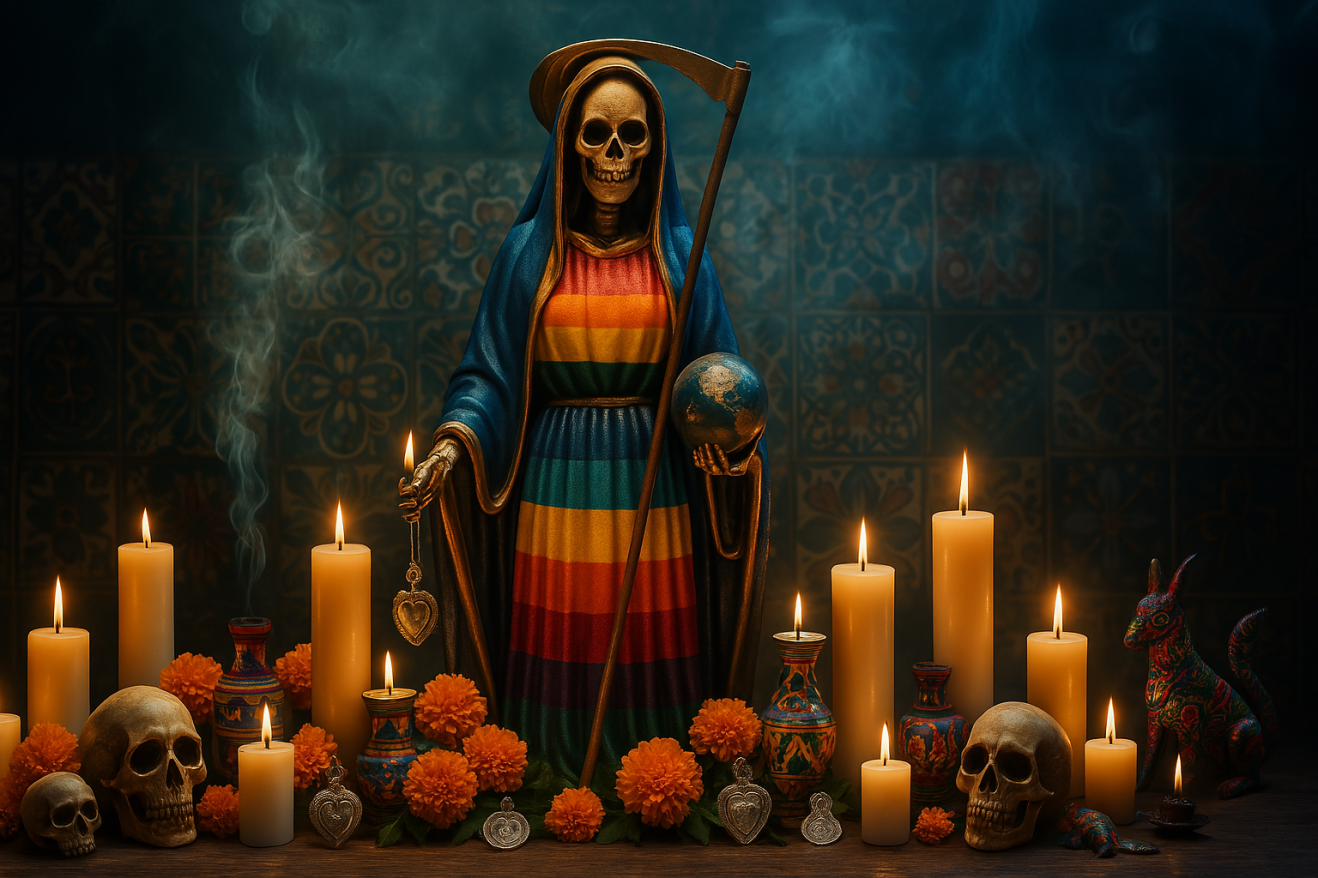Santa Muerte: A Controversial and Powerful Figure in Mexican Culture

Santa Muerte: A Controversial and Powerful Figure in Mexican Culture
Origins and History of Santa Muerte
Santa Muerte, or "Saint Death" in English, is a complex religious and cultural figure that emerged in Mexico and has spread worldwide. Often depicted as a female skeleton dressed in a robe and bearing various symbols, she is venerated by millions of people. Both feared and respected, her cult sparks passionate debates among theologians, sociologists, and anthropologists. This essay explores in depth the history, beliefs, practices, and influence of Santa Muerte, focusing on her impact in Mexico, the United States, Europe, and France.
The exact origins of Santa Muerte are difficult to trace, but they seem to stem from a synthesis of pre-Hispanic, Catholic, and popular beliefs. Pre-Columbian civilizations, such as the Aztecs and Mayans, had deities associated with death, like Mictlantecuhtli and Ah Puch. With the arrival of Spanish conquistadors and the forced Christianization of indigenous populations, these ancient beliefs blended with Catholicism, giving birth to syncretic forms of spirituality.
Santa Muerte, as we know her today, began to emerge in the 20th century, particularly in poor neighborhoods and marginalized communities in Mexico. She is often seen as a protective figure, capable of interceding on behalf of the faithful in desperate situations. Her cult developed informally, without an official hierarchical structure, and spread mainly through word of mouth and community networks.
Beliefs and Practices Associated with Santa Muerte
The beliefs surrounding Santa Muerte are varied and often personal. She is seen as a figure of protection, healing, justice, and vengeance. Devotees seek her help for problems ranging from health and prosperity to protection against enemies and evil forces. Santa Muerte is also associated with darker aspects of life, such as crime and violent death, contributing to her controversial reputation.
Practices of venerating Santa Muerte include rituals, prayers, offerings, and pilgrimages. Altars dedicated to Santa Muerte are often adorned with statues, candles, flowers, food, and other offerings. The colors of the candles and the statue's clothing have specific meanings: red for love and passion, white for purity and protection, black for vengeance and protection against black magic, etc. Devotees often pray to Santa Muerte by reciting specific prayers or writing letters requesting her intervention.
The Influence of Santa Muerte in Mexico
In Mexico, Santa Muerte has become a central figure in the religious and cultural life of many communities. She is particularly popular in poor neighborhoods and rural areas, where people turn to her for help in difficult situations. The cult of Santa Muerte has also gained popularity among marginalized groups, including criminals, prostitutes, and migrants.
The Mexican government and the Catholic Church have often condemned the cult of Santa Muerte, labeling it as satanic and dangerous. However, these condemnations have only increased her popularity among those who feel excluded or ignored by traditional institutions. Santa Muerte has become a symbol of resistance and defiance, representing the struggles and hopes of the marginalized.
The Expansion of the Santa Muerte Cult in the United States
In the United States, the cult of Santa Muerte has taken root mainly among Mexican immigrant communities. Migrants brought their beliefs and practices with them, and Santa Muerte has become a figure of comfort and protection in an often hostile environment. The cult has also spread among broader Latino communities, including Puerto Ricans, Cubans, and Salvadorans.
Santa Muerte is often venerated in private shrines and home altars, but there are also temples and churches dedicated to her cult. These places of worship serve as community centers, providing spiritual and emotional support to devotees. The cult of Santa Muerte has also attracted the attention of law enforcement and the media due to its associations with crime and illegal activities. However, for many devotees, Santa Muerte represents a force of protection and justice rather than an incitement to violence.
Santa Muerte in Europe and France
In Europe, the cult of Santa Muerte is less widespread but is gaining popularity, particularly among Latino immigrant communities. In France, Santa Muerte is venerated mainly by individuals and small groups, often in private contexts. Altars and rituals are adapted to local realities, and devotees find in Santa Muerte a figure of comfort and protection in a foreign environment.
Santa Muerte has also attracted the attention of European researchers and anthropologists, who study her cult as an example of religious syncretism and cultural resistance. The practices of venerating Santa Muerte in Europe are often influenced by local traditions, creating hybrid forms of spirituality.
Santa Muerte and Crime
One of the most significant controversies surrounding Santa Muerte concerns her associations with crime. Due to her reputation as a protector of the marginalized and desperate, Santa Muerte is often venerated by individuals involved in illegal activities, including drug traffickers, gang members, and criminals. These associations have contributed to her sulfurous reputation and have often led to condemnations by authorities and religious institutions.
However, it is important to note that the vast majority of Santa Muerte devotees are ordinary people seeking help and comfort in difficult situations. For them, Santa Muerte represents a force of protection and justice rather than an incitement to violence or crime. Associations with crime are often exaggerated and used to stigmatize devotees and their practices.
Santa Muerte and Popular Culture
Santa Muerte has also had a significant impact on popular culture, appearing in films, TV series, novels, and artworks. She is often depicted as a mysterious and powerful figure capable of influencing individuals' destinies. This representation has contributed to her popularity and spread worldwide.
In music, Santa Muerte is often mentioned in the lyrics of rap, reggaeton, and Latin rock songs. Artists use her image to express themes of rebellion, resistance, and survival. In visual art, Santa Muerte is often depicted in sculptures, paintings, and graffiti, reflecting her presence in the daily life of communities.
Santa Muerte and the Challenges of Modernity
The cult of Santa Muerte poses significant challenges to religious institutions and modern authorities. As a figure of resistance and defiance, Santa Muerte questions established power structures and social norms. She offers an alternative to traditional forms of spirituality and religion, emphasizing individual autonomy and the quest for justice.
However, the cult of Santa Muerte also poses ethical and moral challenges. Her associations with crime and violence raise questions about individual and collective responsibility. Devotees must navigate between their desire for protection and justice and the ethical implications of their practices.
Conclusion
Santa Muerte is a complex and powerful figure that emerged from the depths of Mexican culture and has spread worldwide. She represents a synthesis of pre-Hispanic, Catholic, and popular beliefs, offering an alternative to traditional forms of spirituality and religion. The cult of Santa Muerte poses significant challenges to religious institutions and modern authorities by questioning established power structures and social norms.
In Mexico, the United States, Europe, and France, Santa Muerte is venerated by millions of people seeking help and comfort in difficult situations. Both feared and respected, her cult sparks passionate debates among theologians, sociologists, and anthropologists. Despite the controversies and stigmatization, Santa Muerte continues to attract devotees and influence popular culture, reflecting the struggles and hopes of the marginalized and desperate.
Ultimately, Santa Muerte is a powerful symbol of resistance and defiance, representing the aspirations and challenges of modernity. She reminds us of the importance of the quest for justice, protection, and comfort in an often hostile and uncertain world.

















Comments : 0